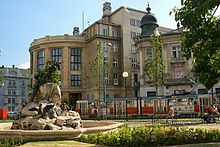Comenius University
| Univerzita Komenského v Bratislave | |

Comenius University building in central Bratislava
|
|
| Latin: Universitas Comeniana Bratislavensis | |
|
Former names
|
Bratislava University of Czechoslovakia Slovak University |
|---|---|
| Type | Public |
| Established | 1919 |
| Endowment | € 129 million (2010) |
| Rector | Karol Mičieta |
| Students | 26,624 (2014/15) |
| 2,276 | |
| Address | Šafárikovo námestie 6, 818 06 Bratislava 1, Bratislava, Slovak Republic |
| Nickname | UK |
| Affiliations | Erasmus, Utrecht Network |
| Website | www.uniba.sk |
Comenius University in Bratislava (Slovak: Univerzita Komenského v Bratislave) is the largest university in Slovakia, with most of its faculties located in Bratislava. It was founded in 1919, shortly after the creation of Czechoslovakia. It is named after Jan Amos Comenius, a 17th-century Czech teacher and philosopher.
In 2006, Comenius University had more than 30,000 students and 2,000 faculty members. As are most universities in Slovakia, it is funded mostly by the government. Although there have been plans to establish tuition fees for university students in Slovakia for years, another attempt failed to gain sufficient support in parliament in May 2005.
The Comenius University was established in 1919 with assistance from the more established University of Prague. It was meant to replace the former Elisabeth University which was located in Bratislava since 1912 as the latter has been forcefully disbanded in 1919 by Samuel Zoch, plenipotentiary župan of Slovakia. This has caused the majority of the university's professors (and some of the students) to take refuge in Budapest, where the Elisabeth University was reestablished. It has been later moved to Pécs and renamed to University of Pécs. This persecution of former (predominantly Hungarian) pillars of education in Bratislava necessitated the recruitment of Czech academicians. Therefore, many professors of the newly established university, including its first rector, Prof. MUDr. Kristian Hynek, were Czechs, since Slovakia at that time did not have enough educated Slovak speakers who could serve as faculty members. In spite of personnel, financial, and space difficulties, the university developed research and teaching programs. The Faculty of Medicine opened in 1919, and was quickly followed by the Faculties of Law and Philosophy in 1921. The Faculty of Philosophy, besides offering programs in the humanities and social science, also educated much-needed teachers for Slovakia's high schools.
...
Wikipedia
